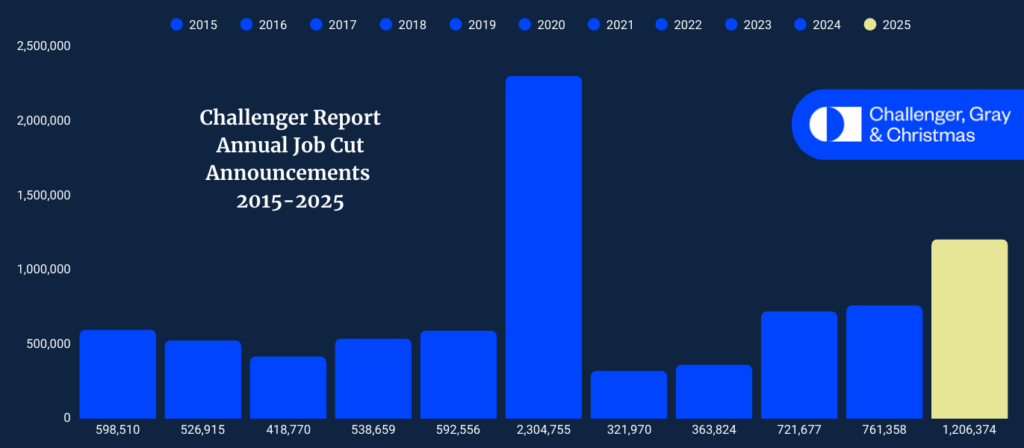
Jan 08 2025 Year-End Challenger Report: Highest Q4 Layoffs Since 2008; Lowest YTD Hiring Since 2010
JOB CUTS FALL TO LOWEST LEVEL IN 17 MONTHS; HIGHEST DECEMBER HIRING SINCE 2022. YTD JOB CUTS 7th HIGHEST SINCE 1989
Published January 8, 2026
U.S.-based employers announced 35,553 job cuts in December, down 50% from the 71,321 job cuts announced in November. It is down 8% from the 38,792 job cuts announced in the same month last year, according to a report released Thursday from global outplacement and executive coaching firm Challenger, Gray & Christmas.
December’s total is the lowest monthly total since 25,885 cuts were announced in July 2024. It is the lowest December total since 2023, when 34,817 cuts were announced. It is the fourth time this year job cuts were lower than the corresponding month one year earlier.
“The year closed with the fewest announced layoff plans all year. While December is typically slow, this coupled with higher hiring plans, is a positive sign after a year of high job cutting plans,” said Andy Challenger, workplace expert and chief revenue officer for Challenger, Gray & Christmas.

In 2025, employers announced 1,206,374 job cuts, an increase of 58% from the 761,358 announced in 2024. Annual job cuts are at the highest level since 2020 when 2,304,755 cuts were announced. It is the seventh highest annual total since 1989.
2020 | 2,304,755 |
2001 | 1,956,876 |
2002 | 1,466,823 |
2009 | 1,288,030 |
2003 | 1,236,426 |
2008 | 1,223,993 |
2025 | 1,206,374 |
In the fourth quarter, employers announced plans to cut 259,948, the highest fourth-quarter total since 2008 when 460,903 cuts were recorded. It is up 29% from the 202,118 cuts recorded in the third quarter of 2025 and up 71% from the 152,116 cuts recorded in the same quarter one year prior. It is the highest quarterly total since the first quarter of 2025 when 497,052 cuts were announced.
WHICH INDUSTRIES CUT THE MOST IN 2025?
The Government led all industries in job cut announcements with 308,167, primarily in the Federal Government. This is up 703% from the 38,375 job cuts in the Government sector in 2024. Job cuts in this sector tapered off significantly since the first quarter. In Q1, 279,445 Government job cuts were announced. In the succeeding 9 months, 28,722 job cuts in this sector were announced.
Technology led in private-sector job cuts with 154,445 in 2025, including 909 in December, an increase of 15% from 133,988 job cuts in this sector in 2024.
Technology has been pivoting to both developing and implementing artificial intelligence much more quickly than any other industry. This coupled with over-hiring over the last decade created a wave of job loss in the industry,” said Challenger.
Companies in Warehousing announced 95,317 job cuts in 2025 as that industry grapples with supply chain, shifting consumer behavior, and automation. Job cuts in this sector are up 317% from the 22,874 announced in 2024.
Similarly, Retail companies contended with shifting consumers, higher prices, tariff uncertainty and consumer spending. In 2025, this industry announced 92,989 job cuts, up 123% from the 41,686 cuts announced in 2024.
The Services sector, which includes companies that provide support to other businesses such as cleaning, staffing, and outsourcing firms, announced 74,796 job cuts in 2025, up 68% from 44,433 announced in 2024.
“Generally during times of uncertainty or economic constraints, companies cut vendors and outside services before looking at their own workforces. Given the environment in 2025, it made sense that Service companies lost contracts and workers,” said Challenger.
The Media industry has announced 17,163 cuts in 2025, with none announced in December. This is up 15% from the 15,039 cuts announced in 2024.
News, which Challenger tracks as a subset of Media and includes broadcast, digital, and print, has announced 2,254 job cuts in 2025. News cuts are down 54% from the 4,902 cuts announced during 2024.
WHY ARE COMPANIES CUTTING IN 2025?
In December, Store, unit, or department Closing led all reasons for cuts, with 12,949 and 191,480 for the year. Market and Economic Conditions followed with 8,120 cuts announced during the month, bringing the 2025 total to 253,206. Restructuring accounted for 5,356 job cuts in December, bringing its 2025 total to 133,611.
Artificial Intelligence (AI) was cited for 142 job cuts in December. So far this year, AI has been responsible for 54,836 announced layoff plans. Since 2023, when this reason was first tracked, AI has been cited in 71,825 job cut announcements.
Tariffs were cited for 7,908 job cuts in 2025, though no tariff-related cuts were announced in December.
DOGE Actions was the leading reason for job cut announcements in 2025, responsible for 293,753 planned layoffs. This includes direct reductions to the federal workforce and its contractors. An additional 20,976 cuts have been attributed to DOGE Downstream Impact, reflecting the loss of federal funding to private and nonprofit entities.
HIRING PLANS IN 2025
In December, employers announced 10,496 hiring plans, the highest total for the month since 2022 when 51,693 December hiring plans were announced. It is up 16% from the 9,074 hiring plans announced in November. It is up 31% from the 7,999 hiring plans announced in December 2024.
Last year, U.S. employers announced 507,647 planned hires, down 34% from the 769,953 announced in 2024. It is the lowest year-to-date total since 2010, when 402,608 new hires were planned that year.
Included in Challenger’s hiring figure are 372,520 seasonal hiring plans in the fourth quarter, the lowest number of announced seasonal hires since Challenger began tracking them in 2012. The firm did not find any new seasonal hiring plans in November or December.
